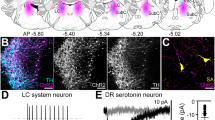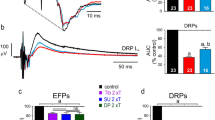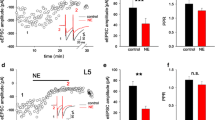Abstract
The central noradrenergic system participates in diverse nervous functions. Nevertheless, our knowledge of the action of adrenoceptors in motor regulation is still lacking. Intriguingly, reticulospinal neurons in the caudal pontine reticular nucleus (PnC) receive fairly dense noradrenergic innervation and play an important role in motor control. Here, after demonstrating the expression of α1- and α2-adrenoceptors in the PnC, we found that noradrenaline elicited a post-synaptic effect (inward or outward whole-cell current at −70 mV holding) on PnC reticulospinal neurons. The α1- and α2-adrenoceptors were co-expressed in individual PnC reticulospinal neurons to mediate an inward and an outward current component at −70 mV holding, respectively, which, when superposed, produced the overall post-synaptic effects of noradrenaline (NA). More importantly, the activation of post-synaptic α1- or α2-adrenoceptors indeed exerted opposing modulations (excitation vs. inhibition) on the firing activities of individual PnC reticulospinal neurons. Furthermore, the activation and inhibition of the Na+-permeable non-selective cationic conductance (NSCC) were demonstrated to be coupled to α1- and α2-adrenoceptors, respectively. Additionally, the activation of α2-adrenoceptors activated K+ conductance. Pre-synaptically, the α2-adrenoceptors were expressed to attenuate the miniature excitatory postsynaptic current (mEPSC) in PnC reticulospinal neurons, but not to affect the miniature inhibitory postsynaptic current (mIPSC). Consistently, the evoked EPSC in PnC reticulospinal neurons was suppressed after the activation of pre-synaptic α2-adrenoceptors. Thus, the excitatory input and post-synaptic dynamics of PnC reticulospinal neurons are indeed intricately modulated by the activation of α1- and α2-adrenoceptors, through which motor control may be regulated in an adaptive manner by the central noradrenergic system.








Similar content being viewed by others
References
Moore RY, Bloom FE (1979) Central catecholamine neuron systems: anatomy and physiology of the norepinephrine and epinephrine systems. Annu Rev Neurosci 2:113–68
Berridge CW, Waterhouse BD (2003) The locus coeruleus-noradrenergic system: modulation of behavioral state and state-dependent cognitive processes. Brain Res Brain Res Rev 42(1):33–84
Sara SJ (2009) The locus coeruleus and noradrenergic modulation of cognition. Nat Rev Neurosci 10(3):211–23
Szabadi E (2013) Functional neuroanatomy of the central noradrenergic system. J Psychopharmacol 8:659–93
Day HE, Campeau S, Watson SJ Jr, Akil H (1997) Distribution of alpha 1a-, alpha 1b- and alpha 1d-adrenergic receptor mRNA in the rat brain and spinal cord. J Chem Neuroanat 13(2):115–39
Happe HK, Coulter CL, Gerety ME, Sanders JD, O'Rourke M, Bylund DB, Murrin LC (2004) Alpha-2 adrenergic receptor development in rat CNS: an autoradiographic study. Neuroscience 123(1):167–78
Hein L (2006) Adrenoceptors and signal transduction in neurons. Cell Tissue Res 326(2):541–51
Berridge CW, Schmeichel BE, España RA (2012) Noradrenergic modulation of wakefulness/arousal. Sleep Med Rev 16(2):187–97
Itoi K, Sugimoto N (2010) The brainstem noradrenergic systems in stress, anxiety and depression. J Neuroendocrinol 22(5):355–61
Ono H, Fukuda H (1995) Pharmacology of descending noradrenergic systems in relation to motor function. Pharmacol Ther 68(1):105–12
Wang M, Ramos BP, Paspalas CD, Shu Y, Simen A, Duque A, Vijayraghavan S, Brennan A, Dudley A, Nou E, Mazer JA, McCormick DA, Arnsten AF (2007) Alpha2A-adrenoceptors strengthen working memory networks by inhibiting cAMP-HCN channel signaling in prefrontal cortex. Cell 129(2):397–410
Sara SJ, Bouret S (2012) Orienting and reorienting: the locus coeruleus mediates cognition through arousal. Neuron 76(1):130–41
Doucet EL, Bobadilla AC, Houades V, Lanteri C, Godeheu G, Lanfumey L, Sara SJ, Tassin JP (2013) Sustained impairment of α2A-adrenergic autoreceptor signaling mediates neurochemical and behavioral sensitization to amphetamine. Biol Psychiatry 74(2):90–8
Berridge CW, Arnsten AF (2013) Psychostimulants and motivated behavior: arousal and cognition. Neurosci Biobehav Rev 37(9 Pt A):1976–84
Sun N, Liu XH, Du JQ, Zhu JX, Tang JS, Li Q (2011) Rostroventral medulla-mediated biphasic modulation of the rat cardiosomatic motor reflex. Neuroscience 185:174–82
Funai Y, Pickering AE, Uta D, Nishikawa K, Mori T, Asada A, Imoto K, Furue H (2014) Systemic dexmedetomidine augments inhibitory synaptic transmission in the superficial dorsal horn through activation of descending noradrenergic control: an in vivo patch-clamp analysis of analgesic mechanisms. Pain 155(3):617–28
Kuraishi Y (2015) Noradrenergic modulation of itch transmission in the spinal cord. Handb Exp Pharmacol 226:207–17
Nasse JS, Travers JB (2014) Adrenoreceptor modulation of oromotor pathways in the rat medulla. J Neurophysiol 112(3):580–93
Robertson SD, Plummer NW, de Marchena J, Jensen P (2013) Developmental origins of central norepinephrine neuron diversity. Nat Neurosci 16(8):1016–23
Burgess CR, Peever JH (2013) A noradrenergic mechanism functions to couple motor behavior with arousal state. Curr Biol 23(18):1719–25
Tartas M, Morin F, Barrière G, Goillandeau M, Lacaille JC, Cazalets JR, Bertrand SS (2010) Noradrenergic modulation of intrinsic and synaptic properties of lumbar motoneurons in the neonatal rat spinal cord. Front Neural Circuits 4:4
Morin D, Bonnot A, Ballion B, Viala D (2000) alpha1-Adrenergic receptor-induced slow rhythmicity in nonrespiratory cervical motoneurons of neonatal rat spinal cord. Eur J Neurosci 12(8):2950–66
Kozlov AK, Kardamakis AA, Hellgren Kotaleski J, Grillner S (2014) Gating of steering signals through phasic modulation of reticulospinal neurons during locomotion. Proc Natl Acad Sci U S A 111(9):3591–6
Baker SN (2011) The primate reticulospinal tract, hand function and functional recovery. J Physiol 589(Pt 23):5603–12
Schepens B, Stapley P, Drew T (2008) Neurons in the pontomedullary reticular formation signal posture and movement both as an integrated behavior and independently. J Neurophysiol 100(4):2235–53
Sakai ST, Davidson AG, Buford JA (2008) Reticulospinal neurons in the pontomedullary reticular formation of the monkey (Macaca fascicularis). Neuroscience 163(4):1158–70
Perreault MC, Glover JC (2013) Glutamatergic reticulospinal neurons in the mouse: developmental origins, axon projections, and functional connectivity. Ann N Y Acad Sci 1279:80–9
Yeomans JS, Frankland PW (1995) The acoustic startle reflex: neurons and connections. Brain Res Brain Res Rev 21(3):301–14
Koch M (1999) The neurobiology of startle. Prog Neurobiol 59(2):107–28
Pavlásek J (1989) The startle reaction to an acoustic stimulus in the rat: the effect of noradrenaline administered by microinjection into the pontomedullary reticular formation. Physiol Bohemoslov 38(1):81–91
Geis HR, Schmid S (2011) Glycine inhibits startle-mediating neurons in the caudal pontine reticular formation but is not involved in synaptic depression underlying short-term habituation of startle. Neurosci Res 71(2):114–23
Schmid S, Brown T, Simons-Weidenmaier N, Weber M, Fendt M (2010) Group III metabotropic glutamate receptors inhibit startle-mediating giant neurons in the caudal pontine reticular nucleus but do not mediate synaptic depression/short-term habituation of startle. J Neurosci 30(31):10422–30
Paxinos G, Watson C (2007) The rat brain in stereotaxic coordinates, 6th edn. Academic, San Diego, pp 151–161
Zhang J, Li B, Yu L, He YC, Li HZ, Zhu JN, Wang JJ (2011) A role for orexin in central vestibular motor control. Neuron 69(4):793–804
Brown RE, Sergeeva OA, Eriksson KS, Haas HL (2002) Convergent excitation of dorsal raphe serotonin neurons by multiple arousal systems (orexin/hypocretin, histamine and noradrenaline). J Neurosci 22(20):8850–9
Yamanaka A, Muraki Y, Ichiki K, Tsujino N, Kilduff TS, Goto K, Sakurai T (2006) Orexin neurons are directly and indirectly regulated by catecholamines in a complex manner. J Neurophysiol 96(1):284–98
Kaneko K, Tamamaki N, Owada H, Kakizaki T, Kume N, Totsuka M, Yamamoto T, Yawo H, Yagi T, Obata K, Yanagawa Y (2006) Noradrenergic excitation of a subpopulation of GABAergic cells in the basolateral amygdala via both activation of nonselective cationic conductance and suppression of resting K+ conductance: a study using glutamate decarboxylase 67-green fluorescent protein knock-in mice. Neuroscience 157(4):781–97
Peña F, Ordaz B (2008) Non-selective cation channel blockers: potential use in nervous system basic research and therapeutics. Mini Rev Med Chem 8(8):812–9
O'Donnell J, Zeppenfeld D, McConnell E, Pena S, Nedergaard M (2012) Norepinephrine: a neuromodulator that boosts the function of multiple cell types to optimize CNS performance. Neurochem Res 37(11):2496–512
Willems EW, Valdivia LF, Villalón CM, Saxena PR (2003) Possible role of alpha-adrenoceptor subtypes in acute migraine therapy. Cephalagia 23(4):245–57
Nalepa I, Kreiner G, Bielawski A, Rafa-Zabłocka K, Roman A (2013) α1-Adrenergic receptor subtypes in the central nervous system: insights from genetically engineered mouse models. Pharmacol Rep 65(6):1489–97
Gyires K, Zádori ZS, Török T, Mátyus P (2009) alpha(2)-Adrenoceptor subtypes-mediated physiological, pharmacological actions. Neurochem Int 55(7):447–53
Yang N, Zhang KY, Wang FF, Hu ZA, Zhang J (2014) Dopamine inhibits neurons from the rat dorsal subcoeruleus nucleus through the activation of α2-adrenergic receptors. Neurosci Lett 559:61–6
Saitow F, Konishi S (2000) Excitability increase induced by beta-adrenergic receptor-mediated activation of hyperpolarization-activated cation channels in rat cerebellar basket cells. J Neurophysiol 84(4):2026–34
Vaughan CW, Bandler R, Christie MJ (1996) Differential responses of lateral and ventrolateral rat periaqueductal grey neurones to noradrenaline in vitro. J Physiol 490(Pt 2):373–81
Inokuchi H, Yoshimura M, Polosa C, Nishi S (1992) Adrenergic receptors (alpha 1 and alpha 2) modulate different potassium conductances in sympathetic preganglionic neurons. Can J Physiol Pharmacol 70(Suppl):S92–7
Akasu T, Gallagher JP, Nakamura T, Shinnick-Gallagher P, Yoshimura M (1985) Noradrenaline hyperpolarization and depolarization in cat vesical parasympathetic neurones. J Physiol 361:165–84
Nai Q, Dong HW, Linster C, Ennis M (2010) Activation of alpha1 and alpha2 noradrenergic receptors exert opposing effects on excitability of main olfactory bulb granule cells. Neuroscience 169(2):882–92
Fukuda A, Minami T, Nabekura J, Oomura Y (1987) The effects of noradrenaline on neurones in the rat dorsal motor nucleus of the vagus, in vitro. J Physiol 393:213–31
Haj-Dahmane S, Andrade R (1996) Muscarinic activation of a voltage-dependent cation nonselective current in rat association cortex. J Neurosci 16(12):3848–61
Chakfe Y, Bourque CW (2000) Excitatory peptides and osmotic pressure modulate mechanosensitive cation channels in concert. Nat Neurosci 3(6):572–9
Igata S, Hayashi T, Itoh M, Akasu T, Takano M, Ishimatsu M (2014) Persistent α1-adrenergic receptor function in the nucleus locus coeruleus causes hyperexcitability in AD/HD model rats. J Neurophysiol 111(4):777–86
Li Y, van den Pol AN (2005) Direct and indirect inhibition by catecholamines of hypocretin/orexin neurons. J Neurosci 25(1):173–83
Shields AD, Wang Q, Winder DG (2009) alpha2A-adrenergic receptors heterosynaptically regulate glutamatergic transmission in the bed nucleus of the stria terminalis. Neuroscience 163(1):339–51
Jiménez-Rivera CA, Figueroa J, Vázquez-Torres R, Vélez-Hernandez ME, Schwarz D, Velásquez-Martinez MC, Arencibia-Albite F (2012) Presynaptic inhibition of glutamate transmission by α2 receptors in the VTA. Eur J Neurosci 35(9):1406–15
Pan YZ, Li DP, Pan HL (2002) Inhibition of glutamatergic synaptic input to spinal lamina II(o) neurons by presynaptic alpha(2)-adrenergic receptors. J Neurophysiol 87(4):1938–47
Luo F, Guo NN, Li SH, Tang H, Liu Y, Zhang Y (2014) Reduction of glutamate release probability and the number of releasable vesicles are required for suppression of glutamatergic transmission by β1-adrenoceptors in the medial prefrontal cortex. Neuropharmacology 83:89–98
Haj-Dahmane S, Shen RY (2014) Chronic stress impairs α1-adrenoceptor-induced endocannabinoid-dependent synaptic plasticity in the dorsal raphe nucleus. J Neurosci 34(44):14560–70
Komaki A, Shahidi S, Sarihi A, Hasanein P, Lashgari R, Haghparast A, Salehi I, Arami MK (2013) Effects of neonatal C-fiber depletion on interaction between neocortical short-term and long-term plasticity. Basic Clin Neurosci 4(2):136–45
Fendt M, Koch M (1999) Cholinergic modulation of the acoustic startle response in the caudal pontine reticular nucleus of the rat. Eur J Pharmacol 370(2):101–7
Matsuyama K, Mori F, Nakajima K, Drew T, Aoki M, Mori S (2004) Locomotor role of the corticoreticular-reticulospinal-spinal interneuronal system. Prog Brain Res 143:239–49
Le Ray D, Juvin L, Ryczko D, Dubuc R (2011) Chapter 4—supraspinal control of locomotion: the mesencephalic locomotor region. Prog Brain Res 188:51–70
Mori S, Matsui T, Kuze B, Asanome M, Nakajima K, Matsuyama K (1998) Cerebellar-induced locomotion: reticulospinal control of spinal rhythm generating mechanism in cats. Ann N Y Acad Sci 860:94–105
Kalwani RM, Joshi S, Gold JI (2014) Phasic activation of individual neurons in the locus ceruleus/subceruleus complex of monkeys reflects rewarded decisions to go but not stop. J Neurosci 34(41):13656–69
Castelino CB, Schmidt MF (2010) What birdsong can teach us about the central noradrenergic system. J Chem Neuroanat 39(2):96–111
Acknowledgments
This work was supported by the grant 31271166 from the National Natural Science Foundation of China and the grant 2015CB759500 from the National Basic Research Program (973 Program) of China.
Author information
Authors and Affiliations
Corresponding authors
Additional information
Nian Yang and Qi-Cheng Qiao contributed equally to this work.
Rights and permissions
About this article
Cite this article
Yang, N., Qiao, QC., Liu, YH. et al. Adrenoceptor-Mediated Post- and Pre-Synaptic Regulations of the Reticulospinal Neurons in Rat Caudal Pontine Reticular Nucleus. Mol Neurobiol 53, 7089–7106 (2016). https://doi.org/10.1007/s12035-015-9613-4
Received:
Accepted:
Published:
Issue Date:
DOI: https://doi.org/10.1007/s12035-015-9613-4




